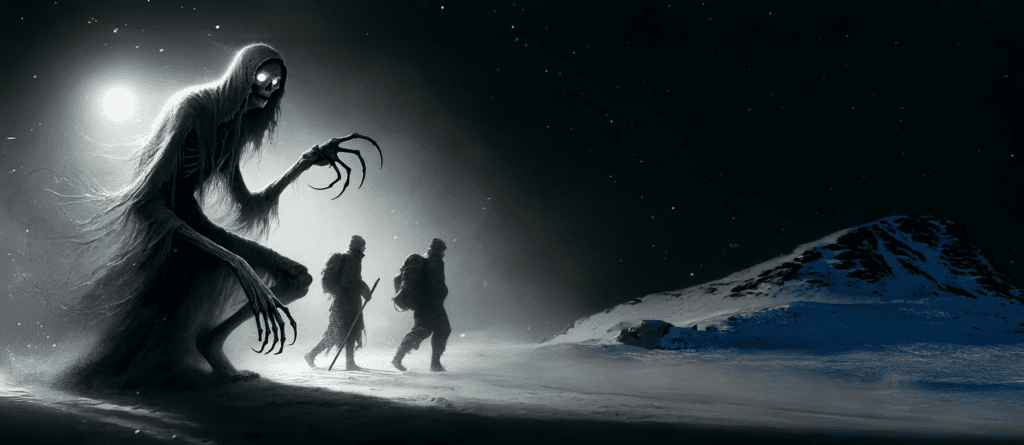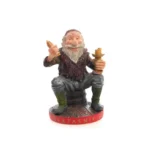Skuggabaldur – Shadow Snatcher

“The shadows moved, though no light had cast them. It was Skuggabaldur, stealing the last trace of daylight from the frozen land.”
Introduction
Skuggabaldur, or Shadow Snatcher, is one of the most eerie and mysterious figures among the forgotten Yule Lads. Unlike his brothers, who primarily target food or cause harmless mischief, Skuggabaldur’s focus is more intangible—he steals shadows. His presence, though barely detectable, leaves a lasting impact, as his theft of shadows causes disorientation and fear in those who encounter him. Legend has it that Skuggabaldur roams the Icelandic countryside, seeking out travelers or villagers to snatch their shadows, leaving them vulnerable to the dark and the dangers of the wilderness.
Historical Background and Earliest Known Reference
Skuggabaldur’s origins are steeped in the belief that a shadow is more than just a reflection of a person but a part of their very soul. In Icelandic folklore, the loss of a shadow was associated with a loss of identity or direction in life. The earliest known references to Skuggabaldur come from oral traditions, passed down in rural communities, where the fear of becoming lost in the winter darkness was ever-present. His inclusion in the Yule Lad tradition reflects the Icelandic people’s deep connection to the natural world and the dangers it posed during the harsh winter months.
Physical Appearance and Clothing
Skuggabaldur is often depicted as a tall, dark figure with no discernible face or features. He moves silently through the night, blending in with the shadows he steals. His clothing is usually described as dark and tattered, resembling the shadows he hunts. Skuggabaldur’s appearance is more ghostly than physical, and many stories suggest that he is more of an ethereal being than a flesh-and-blood creature. His long, thin fingers are said to reach out and snatch the shadows of those who are unaware of his presence, leaving them disoriented and lost.
Likes, Dislikes, and Habits
Skuggabaldur is drawn to dark, quiet places where shadows are plentiful. He prefers the long winter nights, as they provide him with more opportunities to steal the shadows of unsuspecting travelers or villagers. His actions are not motivated by malice, but by a strange, insatiable need to collect shadows. Skuggabaldur dislikes bright light, which makes it difficult for him to steal shadows, and he tends to avoid well-lit areas. His habits are stealthy and calculated, and he often strikes when his victims are unaware, making it nearly impossible to catch him in the act.
Types of Pranks and Mischief
Unlike his more playful brothers, Skuggabaldur’s pranks are far more sinister. His method of stealing shadows leaves his victims disoriented, confused, and often lost in the cold winter wilderness. Those who lose their shadows often find themselves unable to navigate familiar paths, as if the loss of their shadow has severed their connection to the world around them. His pranks are not meant to cause direct harm, but the disorientation and fear they instill can lead to dangerous situations, especially during Iceland’s long, dark winter nights.
Relationship with Humans and Other Yule Lads
Skuggabaldur’s relationship with humans is one of fear and caution. His presence is never welcome, as the loss of a shadow can be disorienting and frightening. Unlike some of the more mischievous Yule Lads, Skuggabaldur does not seek out human interaction or attention, preferring to move silently through the night, unnoticed. Among his brothers, Skuggabaldur is considered one of the more enigmatic and solitary figures. His focus on shadows sets him apart from the food-stealing antics of his siblings, and he is often seen as a more otherworldly and mysterious presence.
Modern Depictions and Popularity
In modern depictions, Skuggabaldur is not as well-known or beloved as some of the other Yule Lads. His eerie, ghostly presence makes him a more unsettling figure, and he is often featured in darker, more atmospheric retellings of the Yule Lad stories. While his antics may not be as humorous as those of his brothers, Skuggabaldur’s story resonates with those who appreciate the eerie and mysterious side of Icelandic folklore. His presence in Christmas traditions is less about mischief and more about the haunting beauty of the winter season.
Fun Facts and Trivia
- Skuggabaldur’s name translates to “Shadow Snatcher,” highlighting his focus on stealing the shadows of his victims.
- The loss of a shadow in Icelandic folklore was believed to symbolize a loss of direction, identity, or grounding in the world.
- Skuggabaldur’s presence in the Yule Lad tradition reflects the fear of becoming lost or disoriented in the long, dark winter nights of Iceland.
Astrological Sign: Scorpio
Skuggabaldur’s secretive and shadowy nature aligns him with the traits of Scorpio. Scorpios are known for their mysterious and intense personalities, much like Skuggabaldur’s stealthy, eerie presence.
Cultural Significance
Skuggabaldur’s story serves as a cautionary tale about the dangers of the dark and the unknown. His character reflects the Icelandic people’s respect for the natural world and the dangers it posed during the winter months. The loss of a shadow, and the disorientation it caused, serves as a reminder of the fragility of life during the harsh winter season.
Voices of Tradition
“Skref Skuggabaldurs skilja engin spor eftir sig, en þjófnaður hans finnst af öllum sem missa skuggana sína við för hans.“




